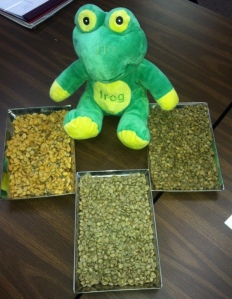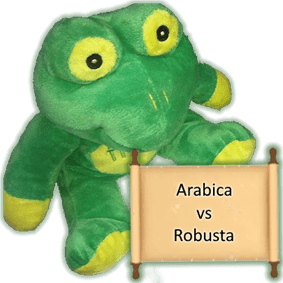
Frog Quaffer and Mzukisi, arrived at Diedrich this morning at 08:40 Feb 6 2012, ready to learn. Here are a few pics from the day. A lot of information to be absorbed
The course started off going through the different areas, and processes coffee goes through before it reaches green been. There are two basic processes as we have discovered before:
- Wet processing
- Dry processing (or what they called natural)
- A method new to us called the Honey method, where the skin is removed and then it is dry processed
There are many ways these processes are done, on micro, midi and massive scales with the resulting coffee being affected by the speed of the process (slower is better), and how natural it is (more natural the better).
At the end of the process you are left with a bean with parchment on, which is left on the bean until it is purhcased, to protect it. Below is a pic, of the bean with parchment on it (looks like peanuts), the dark one is the dry process the lighter one the wet process. Although this we knowledge we had, it was still interesting:

Afterwards we did a coffee cupping with Atlas coffee importers and learnt how to taste tainted coffees, and set up a cupping. This was great fun. We tasted 6 coffees, from all over the world, 4 of them where tongue tingling. Notes of cupping to follow in a later post.
Then we had a tour of the factory

First we saw a 12kg IR that was almost ready to ship:
The designer of the Diedrich roasters, has a rich family history in coffees, with his father first tinkering with roasters when he was a boy in the 60s, and after a stint in the aeronautics industry.


consistency and total control of the roast, allowing proper roast profiling and assessment of the roast at all check points along the roast. The whole product is made of the best quality steel and components to ensure that the roaster works all the time. and a heat exchange which allowed
- Stainless steel drum. Not coated, 100% steel


The roasters have no glue only spot welding and high quality engineering. They are built to produce the best coffee and last forever.
And that was just the morning.
The rest of the day was dedicated to the process of setting up a profile roast per coffee. Coffee needs to be shown respect by the roaster to should honour to those that have produced it. More to come about profile roasting in another post.




I love coffee, too! This is very interesting!
Well keep reading, read you pancake recipe looks good!